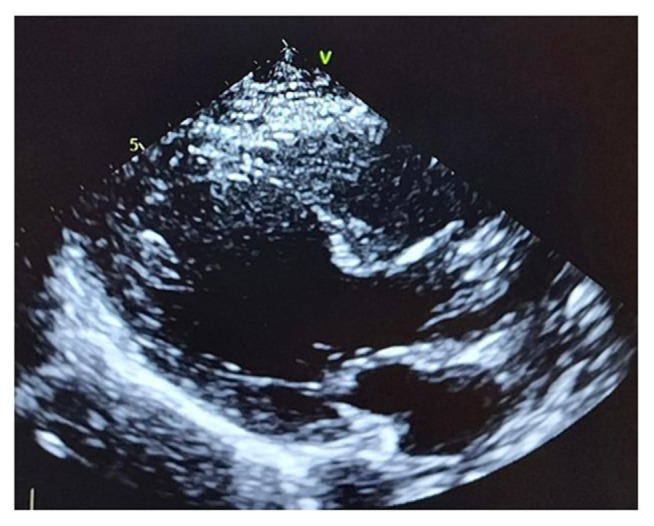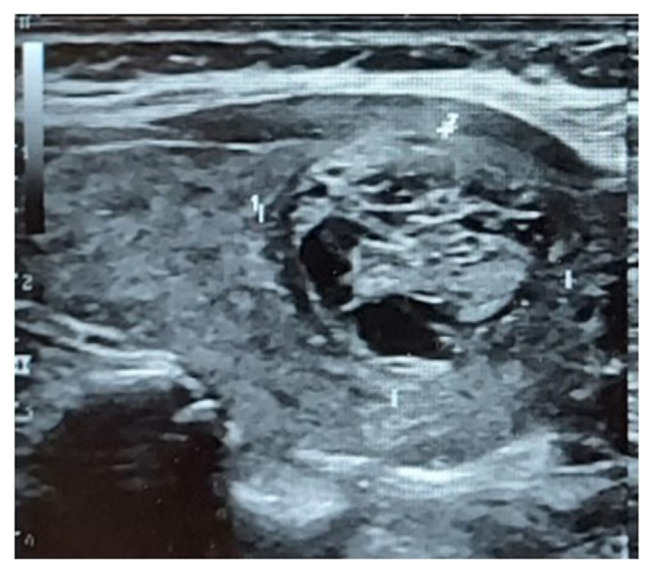Abstract
Takotsubo syndrome (TTS) is a nonischemic cardiomyopathy with transient apical ballooning of the left ventricle and reduced ejection fraction that can be caused by severe emotional or physical stress, with diverse clinical presentations. This case describes a patient who went into cardiac arrest at a casino after winning the lottery. She was found to have Takotsubo cardiomyopathy, in the setting of uncontrolled hyperthyroidism. This is a very unique case of TTS presenting with cardiac arrest, and is also an uncommon example of TTS triggered by a positive rather than negative emotional life event.
Keywords: Takotsubo, Grave’s, Cardiomyopathy, Cardiac arrest, Hyperthyroidism, Thyrotoxicosis
1. Background
Takotsubo syndrome is an acute coronary syndrome, triggered by psychological or emotional extreme stress.1 TTS is characterized by transient left ventricular dysfunction, which resembles myocardial infarction but is not caused by obstructive coronary artery disease.1
The diagnosis of TTS is based on the presence of typical clinical features, electrocardiogram (ECG) changes, and elevated cardiac biomarkers.2 The classic ECG changes in TTS include ST-segment elevation or T-wave inversion, but this isnotnecessary for diagnosis and some patients may have a normal ECG.2 Cardiac biomarkers, such as troponin and creatine kinase-MB, are usually elevated, but their levels are lower than those seen in acute myocardial infarction.2,3 The diagnosis of TTS is confirmed by imaging studies, such as echocardiography, which shows transient apical ballooning or other regional wall motion abnormalities.3
Despite the increasing number of cases reported, the pathophysiology of TTS is still not fully understood, but several theories have been proposed. The most widely accepted hypothesis is that TTS is caused by catecholamine-induced myocardial stunning, causing transient myocardial dysfunction, especially in the apical region.3 Other proposed mechanisms include microvascular dysfunction, coronary artery vasospasm, and direct myocardial injury caused by inflammatory cytokines.3
This is a rare case of Takotsubo cardiomyopathy secondary to Grave’s thyrotoxicosis presenting with cardiac arrest in a patient who had just found out she won the lottery.
2. Case description
Patient is a 39-year-old female who collapsed at a casino after winning the jackpot. She received cardiopulmonary resuscitation by bystanders and was defibrillated twice in the field. She was intubated in the emergency department, admitted to the intensive care unit, and received targeted temperature management.
Her admission vital signs showed tachycardia with heart rate 128 beats/minute and blood pressure 119/82 mm Hg. She was afebrile. ECG showed sinus tachycardia. Laboratory findings demonstrated a lactate of 4.6 mmol/L and elevated troponin I level with a peak of 1.43 ng/mL. Urine drug screen was negative. Echocardiogram showed a left ventricular ejection fraction (EF) of 30–35% with diffuse hypokinesis and apical dilation of the left ventricle (Fig. 1). Computerized tomography angiography of the chest with contrast showed diffuse right lung infiltrates and incidentally thyromegaly with multiple thyroid nodules (Fig. 2). Endocrinologic workup revealed a free thyroxine level of 6.41 ng/dL, total triiodothyronine level of 167 ng/dL, undetectable thyroid stimulating hormone, and positive thyroid stimulating hormone receptor antibody. Her thyroid stimulating immunoglobulin level was elevated at 2.81 IU/L.
Fig. 1.
Transthoracic echocardiogram findings suggestive of Takostubo cardiomyopathy. Echocardiogram on admission showing a reduced EF of 30–35%, with diffuse hypokinesis; additionally, left ventricular apical dilation consistent with Takotsubo cardiomyopathy is seen in the image above.
Fig. 2.
Left thyroid nodule seen on ultrasound. Multiple thyroid nodules were detected on ultrasound, the largest being a 2.6 cm mixed nodule in the left lobe, seen in the image above.
She received intravenous propylthiouracil, hydrocortisone and empiric antibiotics with significant clinical improvement. After she was stabilized and extubated, she explained that she was recently diagnosed with Grave’s disease and her dose of methimazole was increased a few weeks prior to admission. However, she was not adherent to her methimazole regimen. She had an outpatient radioactive iodine uptake scan that reportedly showed increased uptake but she did not know further details about the results. Cardiac catheterization on day 12 of hospitalization showed no obstructive disease, only mild atherosclerosis of the coronary arteries, with minimal apical hypokinesis and an improved EF of 50%.
3. Discussion
This case is a rare example of Takotsubo cardiomyopathy, induced by a positive stressor, presenting with cardiac arrest, in a patient particularly susceptible to TTS given her medical history. As discussed previously, the surge of catecholamines that occurs in TTS can induce severe dysfunction of the microvasculature, impairing perfusion of the myocardium and endothelium-mediated vasodilation, and upregulating vasoconstriction.3 The left ventricle’s apical myocardium is at highest risk in TTS due to the high number of beta-adrenoceptors, and catecholamines themselves appear to have a direct toxic effect on myocardial tissue.4 The most common complaint in patients with TTS is chest pain, approximated to be the chief complaint about 30% of these patients.3 Less commonly, patients can present with life threatening sequelae of TTS, such as cardiogenic shock, ventricular arrhythmias, or cardiac arrest, such as in this patient, which is estimated to occur in approximately 5% of TTS patients. 3,5 Often the biomarkers in TTS do not truly display the degree of left ventricular myocardial dysfunction, with only modest increases in CK-MB and troponin in even severe cases.6
Not all events associated with Takotsubo cardiomyopathy are negative stressors. About 1.5% patients have a positive emotional trigger, referred to as “happy heart syndrome”.7 Strong positive emotions activate the autonomic nervous system to a similar extent as negative emotions,8 and literature such as Ghadri et al.’s 2016 review article suggests that the baseline characteristics and spectrum of presentations of TTS in both the “happy heart” and “broken heart” patient populations are not significantly different.8 Variants of TTS inducing mid-ventricular wall motion abnormalities in particular are especially common in patients who experienced positive emotional stress compared to those who experienced a negative emotional event.8
The risk of TTS occurrence and its potential complications can be largely assessed by the patient’s demographics and medical history. Studies estimate that up to 90% of all TTS cases occur in postmenopausal females, as estrogen is suspected to serve multiple cardioprotective roles.2,3 Furthermore, risk factors for cardiac arrest in acute TTS include male sex, atrial fibrillation, ST-segment elevation on ECG, and elevated C-reactive protein level.5 Interestingly, the patient described in this case report did not have the classic risk factors for cardiac arrest in TTS, nor was she in the typical age demographic of TTS cases as she was premenopausal; nevertheless, she was especially susceptible to TSS and life threatening complications, because she experienced an emotional life event in the setting of uncontrolled Grave’s thyrotoxicosis, as thyroid hormones augment catecholamines’ inotropic and chronotropic effects and increase tissue responsiveness to catecholamines.9–11 Thyroid storm was also considered as a potential cause of her cardiac arrest rather than TTS. Thyroid storm is a life-threating complication of uncontrolled hyperthyroidism, involving multiple organ systems.12 However, her Burch-Wartofsky score was 35, suggestive of a possible impending thyroid storm, but it was never over 45, which would be a score consistent with a true thyroid storm.12
There is no consensus on the optimal treatment regimen for Takotsubo cardiomyopathy and research is ongoing. In the acute phase, treatment is primarily supportive, and includes medical management for blood pressure and heart rate optimization with angiotensin converting enzyme inhibitors and beta-blockers, as well as diuretics if needed to relieve congestive heart failure symptoms. 3,13 Anticoagulation or dual anti-platelet therapy may be considered until systolic function improves, although the precise role and timing of their use is still controversial.13 In unstable patients, intervention with intra-aortic balloon pump placement or extracorporeal membrane oxygenation may be utilized.3,13 Levosimendan is an emerging therapy for TTS complicated by cardiogenic shock, as it is a non-catecholamine inotrope, with multiple cardioprotective functions.13 Levosimendan functions as a calcium-sensitizer, thereby increasing cardiac contractility, and also mediates the opening of adenosine triphosphate-dependent potassium channels on smooth muscles as well as the inner mitochondrial membrane, improving overall perfusion.13 Preliminary studies have suggested that it is associated with shorter hospital stays and faster recovery times for TTS patients who require inotropic support.14 In this patient’s unique case, appropriate treatment of TTS required management of her uncontrolled hyperthyroidism, with methimazole and intravenous steroids given concern for an impending thyroid storm.9,10 Overall, patients generally have a good prognosis, with about 96% of TTS cases having complete recovery.15
4. Conclusion
Takotsubo cardiomyopathy is a unique and fascinating syndrome with various presentations and etiologies. The patient in this case demonstrated a rare example of “happy heart syndrome”, because a positive emotional life event, winning the jackpot at the casino, triggered her TTS.8 The underlying pathophysiology of TTS is still not fully understood, but the catecholamine-induced myocardial stunning theory is the most widely accepted hypothesis.2 Thus, this patient was especially vulnerable to TTS and its life-threatening complications, after experiencing an emotional life event under the backdrop of severely uncontrolled hyperthyroidism. Most cases, such as the patient described here, have good outcomes with restoration of regular cardiac function within weeks; however, more knowledge and research on this complex disease is needed before there can be an established consensus on optimal management and long-term care.12
Footnotes
This research was supported (in whole or in part) by HCA Healthcare and/or an HCA Healthcare affiliated entity. The views expressed in this publication represent those of the author(s) and do not necessarily represent the official views of HCA Healthcare or any of its affiliated entities.
Conflict of interest
No conflicts of interest to disclose.
References
- 1. Templin C, Ghadri JR, Diekmann J, et al. Clinical features and outcomes of takotsubo (stress) cardiomyopathy. N Engl J Med. 2015;373(10):929–938. doi: 10.1056/NEJMoa1406761. [DOI] [PubMed] [Google Scholar]
- 2. Ghadri JR, Wittstein IS, Prasad A, et al. International expert consensus document on takotsubo syndrome (Part I): clinical characteristics, diagnostic criteria, and pathophysiology. Eur Heart J. 2018;39(22):2032–2046. doi: 10.1093/eurheartj/ehy076. [DOI] [PMC free article] [PubMed] [Google Scholar]
- 3. Komamura K. Takotsubo cardiomyopathy: pathophysiology, diagnosis and treatment. World J Cardiol. 2014;6(7):602–609. doi: 10.4330/wjc.v6.i7.602. [DOI] [PMC free article] [PubMed] [Google Scholar]
- 4. Eliades M, El-Maouche D, Choudhary C, Zinsmeister B, Burman KD. Takotsubo cardiomyopathy associated with thyrotoxicosis: a case report and review of the literature. Thyroid. 2014;24:383–389. doi: 10.1089/thy.2012.0384. [DOI] [PMC free article] [PubMed] [Google Scholar]
- 5. Wittstein IS. Cardiac arrest and Takotsubo syndrome. Eur Heart J. 2019;40:2152–2154. doi: 10.1093/eurheartj/ehz324. [DOI] [PubMed] [Google Scholar]
- 6. Pelliccia F, Kaski JC, Crea F, Camici PG. Pathophysiology of takotsubo syndrome. Circulation. 2017;135(24):2426–2441. doi: 10.1161/CIRCULATIONAHA.116.027121. [DOI] [PubMed] [Google Scholar]
- 7. Stiermaier T, Walliser A, El-Battrawy I, et al. Happy heart syndrome: frequency, characteristics, and outcome of takotsubo syndrome triggered by positive life events. J Am Coll Cardiol HF. 2022;10:459–466. doi: 10.1016/j.jchf.2022.02.015. [DOI] [PubMed] [Google Scholar]
- 8. Ghadri JR, Sarcon A, Diekmann J, et al. Happy heart syndrome: role of positive emotional stress in takotsubo syndrome. Eur Heart J. 2016;37(37):2823–2829. doi: 10.1093/eurheartj/ehv757. [DOI] [PMC free article] [PubMed] [Google Scholar]
- 9. Rueda D, Aguirre R, Contardo D, et al. Takotsubo cardiomyopathy and hyperthyroidism: a case report and literature review. Am J Case Rep. 2017;18:865–870. doi: 10.12659/ajcr.905121. [DOI] [PMC free article] [PubMed] [Google Scholar]
- 10. Patel K, Griffing GT, Hauptman PJ, Stoker JM. Recurrent Takotsubo cardiomyopathy related to recurrent thyrotoxicosis. Tex Heart Inst J. 2016;43(2):152–155. doi: 10.14503/THIJ-15-5046. [DOI] [PMC free article] [PubMed] [Google Scholar]
- 11. Perkins MJ, Schachter DT. Biventricular takotsubo cardiomyopathy in Grave’s hyperthyroidism. J Invasive Cardiol. 2014;26(3):35–36. [PubMed] [Google Scholar]
- 12. Burch HB, Wartofsky L. Life-threatening thyrotoxicosis. Thyroid storm. Endocrinol Metab Clin N Am. 1993;22(2):263–277. [PubMed] [Google Scholar]
- 13. Bairashevskaia AV, Belogubova SY, Kondratiuk MR, et al. Update of Takotsubo cardiomyopathy: present experience and outlook for the future. Int J Cardiol Heart Vasc. 2022;7(39):100990. doi: 10.1016/j.ijcha.2022.100990. [DOI] [PMC free article] [PubMed] [Google Scholar]
- 14. Jaguszewski MJ, Gasecka A, Hering D, et al. Levosimendan improves the acute course of takotsubo syndrome: a pooled analysis. ESC Heart Fail. 2021;8(5):4360–4363. doi: 10.1002/ehf2.13486. [DOI] [PMC free article] [PubMed] [Google Scholar]
- 15. Elesber AA, Prasad A, Lennon RJ, Wright RS, Lerman A, Rihal CS. Four-year recurrence rate and prognosis of the apical ballooning syndrome. J Am Coll Cardiol. 2007;50:448–452. doi: 10.1016/j.jacc.2007.03.050. [DOI] [PubMed] [Google Scholar]




